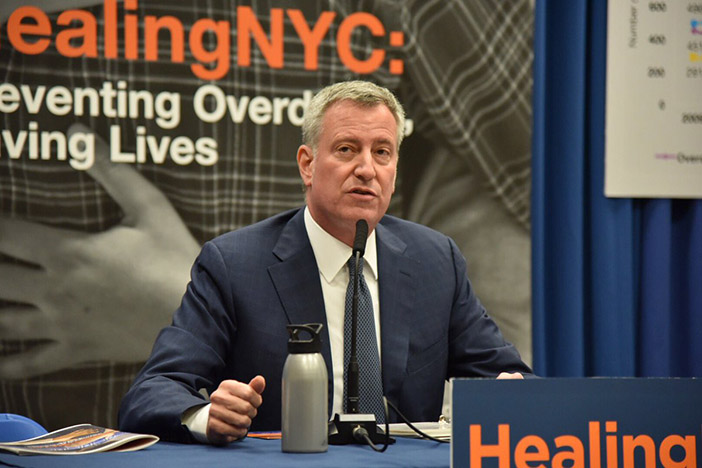Photo Courtesy of NYPD
Mayor de Blasio noted that in 2016, more than 1,000 people in New York City died in a drug overdose which involved an opioid, the highest year on record.
By Michael V. Cusenza
The City on Monday launched a new effort – HealingNYC – to reduce opioid overdose deaths by 35 percent over the next five years.
According to the administration, in 2016, more than 1,000 people across the five boroughs died in a drug overdose which involved an opioid, the highest year on record. More New Yorkers died from opioid overdoses last year than from car accidents and homicides combined, City officials said.
“The opioid epidemic is a growing crisis that affects not only users, but also their loved ones,” said Mayor Bill de Blasio. “If we’re going to start winning the battle against opioids, we need to start talking honestly about what works and invest in the strategic measures that will stop abuse, break addiction and save lives. HealingNYC is our plan to treat and help those struggling with addiction – and prevent more from falling under the control of these powerful drugs.”
Through HealingNYC, the City will focus its efforts on four main goals to combat this epidemic, and invest $38 million annually at full ramp-up to implement the following strategies:
Prevent opioid overdose deaths – The City will distribute 100,000 naloxone kits to the Department of Health and Mental Hygiene, the Police Department, the Department of Social Services and Correctional Health Services, a division of NYC Health + Hospitals, so that healthcare providers, first responders and shelter providers can have access to the tools they need to save lives.
Prevent opioid misuse and addiction – In 2017, ThriveNYC will create additional mental health clinics in high-need schools that account for a disproportionate share of suspensions and mental health issues, which can be precursors for substance misuse. As part of the City’s ongoing effort to raise awareness about addiction and end the stigmas attached to seeking effective treatment, the City will build on “Save a Life, Carry Naloxone” public awareness campaign and will connect up to five of the communities at highest risk with targeted prevention messages and care. The City will also educate clinicians on best practices for judicious prescribing, and expand the Nonfatal Overdose Response System to a total of 10 high-risk neighborhoods, up from three from 2017 to 2019.
Connect New Yorkers to effective treatment – An additional 20,000 New Yorkers will have access to medication-assisted treatment by 2022. NYC Health + Hospitals will transform its substance use care models to become a system of excellence in addressing harmful opioid use. The City will also build on the work of the Mayor’s Task Force on Behavioral Health and Criminal Justice System to target treatment and expand resources in the criminal justice system.
Reduce the supply of dangerous opioids – In 2017, the Administration will make new investments in the Office of the Chief Medical Examiner and the NYPD to increase the kinds of testing and information sharing that the City needs to get a better understanding of the local drug environment. To build upon existing efforts in Staten Island, the Police Department will create new Overdose Response Squads that will target dealers in other high-risk neighborhoods in New York City. The City will assign 84 detectives and hire 50 lab personnel at the NYPD to combat this epidemic and disrupt the supply of opioids before they come into the city.
“We must use every tool at our disposal to combat the opioid addiction crisis that is continuing to destroy the lives of New Yorkers in New York City and around the state,” said State Attorney General Eric Schneiderman. “I welcome Mayor de Blasio’s innovative HealingNYC initiative, which seeks to strategically attack this epidemic from all angles. I am proud of the work my office has done to fight the scourge of addiction, from making naloxone more affordable for hundreds of communities across the state, to removing barriers to life-saving addiction treatment – and we will continue to work with Mayor de Blasio and our partners in government to ensure that those New Yorkers struggling with addiction receive the help and support they need.”

